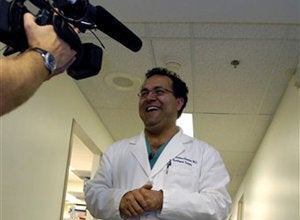
Access to health care is a complex matter, ranging from availability of health professionals in one's community to many barriers to care, such as racial/ethnic, geographic, and literacy factors. But as the costs of health care surge ever higher, the financial barrier to care has clearly become the biggest impediment of all. Having insurance used to offer some protection against this barrier, but does so less all the time as the numbers of uninsured and under-insured grow.
As we saw in our last post, the health insurance industry claims, through AHIP, its national trade group, "to expand access to high-quality, cost-effective health care to all Americans." Let's examine how well the industry does in meeting that goal.
For many, it's hard to imagine that at one time health insurance really did assure access to care. Yet at one time, in the early years of the industry, people were insured without regard to pre-existing conditions or their claims experience. Prior to the 1960s, such medical underwriting practices were considered unethical. Reasonable coverage was provided to all comers for community-rated premiums. Today, most insurers try to select healthier enrollees and avoid exposure to higher-risk enrollees and their higher costs of care. To find the last time Americans could depend on health insurance to assure access to care, one has to go back in history at least 40 years; those days are long gone.
The track record of the industry makes it obvious that it can never expand access to care for all Americans. How can AHIP leaders keep a straight face in continuing to proclaim such a mission in view of these inconvenient facts?
• Of 300 million Americans, 47 million are uninsured and tens of millions underinsured with little protection against the costs of significant illness or injury.
• Employer-sponsored insurance (ESI), once a mainstay of coverage for working Americans, now covers less than three of five workers; more than one-half of small employers no longer offer their employees either health insurance coverage or benefits toward purchasing coverage.
• Even when insured, one-half of women between 19 and 64 years of age spend more than 10 percent of their income on out-of-pocket health care expenses. According to a recent analysis by the Henry J. Kaiser Family Foundation, seniors with supplemental Medigap policies actually spend more of their income on premiums and health care than any other group of seniors, including those with traditional Medicare without Medigap coverage.
• As private insurance markets continue to shrink, the industry turns to generously subsidized public markets; however, growth there is limited by its high costs and is only possible when the government hands out large subsidies (private Medicare Advantage plans, for example, receive subsidies 12 to 19 percent above the costs of traditional Medicare).
These inconvenient truths expose the industry's goal of expanding access to care as just one more example of self-serving rhetoric without any basis in fact. Just what do we get for continuing to prop up this industry? That's the subject of the next post.
Adapted from Do Not Resuscitate: Why the Health Insurance Industry is Dying, and How We Must Replace It, forthcoming, August 2008 by John Geyman. With permission of the publisher, Common Courage Press.